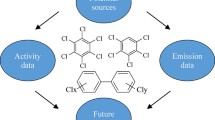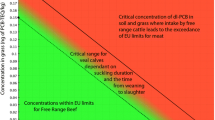Abstract
Polychlorinated biphenyls (PCBs) are ubiquitously distributed in the environment and produce multiple adverse effects in humans and wildlife. As a result, the purpose of our study was to characterize PCB sources in anthropogenic materials and releases to the environment in Washington State (USA) in order to formulate recommendations to reduce PCB exposures. Methods included review of relevant publications (e.g., open literature, industry studies and reports, federal and state government databases), scaling of PCB sources from national or county estimates to state estimates, and communication with industry associations and private and public utilities. Recognizing high associated uncertainty due to incomplete data, we strived to provide central tendency estimates for PCB sources. In terms of mass (high to low), PCB sources include lamp ballasts, caulk, small capacitors, large capacitors, and transformers. For perspective, these sources (200,000–500,000 kg) overwhelm PCBs estimated to reside in the Puget Sound ecosystem (1500 kg). Annual releases of PCBs to the environment (high to low) are attributed to lamp ballasts (400–1500 kg), inadvertent generation by industrial processes (900 kg), caulk (160 kg), small capacitors (3–150 kg), large capacitors (10–80 kg), pigments and dyes (0.02–31 kg), and transformers (<2 kg). Recommendations to characterize the extent of PCB distribution and decrease exposures include assessment of PCBs in buildings (e.g., schools) and replacement of these materials, development of Best Management Practices (BMPs) to contain PCBs, reduction of inadvertent generation of PCBs in consumer products, expansion of environmental monitoring and public education, and research to identify specific PCB congener profiles in human tissues.
Similar content being viewed by others
References
49 FR 28172 (Fed Reg) PCBs (1984) Manufacturing, processing, distribution in commerce and use prohibitions; exclusions, and authorizations. 7/10/1984
Buck Louis G, Sundaram R et al (2013) Persistent environmental pollutants and couple fecundity: the LIFE study. Environ Health Perspect 121(2):231–235
Bursian SJ, Richard JK, Remington RE, Link JE, Fitzgerald SD (2013) Dietary exposure of mink (Mustela vison) to fish from the Upper Hudson River, New York, USA: effects on reproduction and offspring growth and mortality. Environ Toxicol Chem 32(4):780–793
CCME (Canadian Council of Ministers of the Environment) (1995) PCB transformer decontamination standards and protocols, 44 p
CDC (Centers for Disease Control and Prevention) (2009) Fourth national report on human exposure to environmental chemicals. Dept of Health and Human Services, Atlanta, GA. http://stacks.cdc.gov/view/cdc/21813
Christie RM (2013) Alternatives for elimination of polychlorinated biphenyls (PCBs) in pigments used for printing inks and architectural paints, Report to the Washington Dept. of Ecology, 30 p
Davis JM, Hetzel F, Oram JJ, McKee LJ (2007) Polychlorinated biphenyls (PCBs) in San Francisco Bay. Environ Res 105:67–86
Delistraty D (2013) Ecotoxicity and risk to human fish consumers of polychlorinated biphenyls in fish near the Hanford site (USA). Tot Sci Environ 445–446:14–21
Diamond ML, Melymuk L, Ciczar SA, Robson M (2010) Estimation of PCB stocks, emissions, and urban fate: will our policies reduce concentrations and exposure? Environ Sci Technol 44(8):2777–2783
Ecology (Washington Dept of Ecology) (2000) Proposed strategy to continually reduce persistent, bioaccumulative toxics (PBTs) in Washington State. Ecology Pub No 00-03-054
Ecology (Washington Dept of Ecology) (2011a) Control of toxic chemicals in Puget Sound: assessment of selected toxic chemicals in the Puget Sound Basin, 2007–2011. Ecology Pub No. 11-03-055
Ecology (Washington Dept of Ecology) (2011b) Control of toxic chemicals in Puget Sound phase 3: primary sources of selected toxic chemicals and quantities released in the Puget Sound Basin. Ecology Pub No 11-03-024
Ecology (Washington Dept of Ecology) (2011c) Serdar D, Lubliner B, Johnson A, Norton D. Spokane River PCB source assessment 2003–2007. Ecology Pub No 11-03-013
Ecology (Washington Dept of Ecology) (2014) Polychlorinated biphenyls (PCBs) in general consumer products. Ecology Pub No 14-04-035
Ecology (Washington Dept of Ecology) (2015) PCB Chemical Action Plan. Ecology Pub No 15-07-002
EIM Database (Environmental Information Management Database) (2014) Washington Dept of Ecology, Olympia, WA
Eisler R (1986) Polychlorinated biphenyl hazards to fish, wildlife, and invertebrates: a synoptic review. Contaminant Hazard Rev, Rep No 7., Fish and Wildlife Service, US Dept of the Interior
EPA (US Environmental Protection Agency) (1982) Polychlorinated biphenyls (PCBs), use in electrical equipment, proposed Rule. 40 CFR Part 761, Fed Reg 47 (78), April 22
EPA (US Environmental Protection Agency) (1987) Locating and estimating air emissions from sources of polychlorinated biphenyls (PCB). EPA-450/4-84-007n
EPA (US Environmental Protection Agency) (1997) Management of polychlorinated biphenyls in the United States. www.chem.unep.ch/pops/indxhtms/cspcb02.html
EPA (US Environmental Protection Agency) (2012) Polychlorinated biphenyls (PCBs) in school buildings: sources, environmental levels, and exposures. EPA/6000/R-12/051
EPA (US Environmental Protection Agency) (2014) PCB Transformer registration database. http://catalog.data.gov/dataset/polychlorinated-biphenyls-pcb-transformer-registration-database#
EPA/EC (US Environmental Protection Agency/Environment Canada) (2009) Great lakes binational toxics strategy, 202 p.
Guo J, Capozzi SJ, Kraeutler TM, Rodenburg LA (2014) Global distribution and local impacts of inadvertently generated polychlorinated biphenyls in pigments. Environ Sci Technol 48:8573–8580
Hamers T, Kamstra J, Cenijn P et al (2011) In vitro toxicity profiling of ultrapure non-dioxin-like polychlorinated biphenyl congeners and their relative toxic contribution to PCB mixtures in humans. Toxicol Sci 121(1):88–100
Heilmann C, Grandjean P, Weihe P et al (2006) Reduced antibody responses to vaccinations in children exposed to polychlorinated biphenyls. PLoS Med 3(8):1352–59
Herrick RF, McClean MD, Meeker JD, Baxter LK, Weymouth GQ (2004) An unrecognized source of PCB contamination in schools and other buildings. Environ Health Perspect 112(10):1051–1053
Hu D, Hornbuckle KC (2010) Inadvertent polychlorinated biphenyls in commercial paint pigments. Environ Sci Technol 44:2822–2827
IC2 (Interstate Chemicals Clearinghouse) (2013) Alternatives assessment guide, Ver 1.0. http://www.theic2.org/alternatives_assessment_guide
Jacobson JL, Jacobson SW (1996) Intellectual impairment in children exposed to polychlorinated biphenyls in utero. N Engl J Med 335:783–789
Jurewicz J, Polanska K, Hanke W (2013) Chemical exposure early in life and the neurodevelopment of children—an overview of current epidemiological evidence. Ann Agricul Environ Med 20(3):465–486
Keeler GJ, Pacyna JM, Bidleman TF, Nriagu JO (1993) Identification of sources contributing to the contamination of the Great Waters by toxic compounds. Prepared for EPA, 164 p
King County (2013) Estimating PCB and PBDE loadings to the Lake Washington watershed: data report. Prepared for US EPA Region 10 by Jack R, Colton J, Water and Land Res Div, King County, Seattle, WA
Klosterhaus S, McKee LJ, Yee D, Kass JM, Wong A (2014) Polychlorinated biphenyls in the exterior caulk of San Francisco Bay area buildings, California, USA. Environ Internat 66:38–43
Kohler M, Tremp J, Zennegg M, Seiler C, Minder-Kohler S, Beck M, Lienemann P, Wegmann L, Schmid P (2005) Joint sealants: an overlooked diffuse source of polychlorinated biphenyls in buildings. Environ Sci Technol 39:1967–1973
Krahn MM, Hanson MB, Baird RW, Boyer RH, Burrows DG, Emmons CK, Ford JKB, Jones LL, Noren DP, Ross RS, Schorr GS, Collier TK (2007) Persistent organic pollutants and stable isotopes in biopsy samples (2004/2006) from southern resident killer whales. Mar Pollut Bull 54:1903–1911
Lauby-Secretan B, Loomis D, Grosse Y, on behalf of the International Agency for Research on Cancer (IARC) Monograph Working Group et al (2013) Carcinogenicity of polychlorinated biphenyls and polybrominated biphenyls. Lancet 14:287–88
METI (Ministry of Economy, Trade and Industry [Japan]) (2013b) Administrative guidance on manufacture, import, etc. of organic pigments that can unintentionally contain polychlorinated biphenyls (Seventh Report), English press release, Report only in Japanese
METI (Ministry of Economy, Trade and Industry [Japan]) et al (2013a) Compiled results of reanalysis of the presence of polychlorinated biphenyls (PCBs) as by-products in organic pigments. English press release, Report only in Japanese
Panero M, Boehme S, Munoz G (2005) Pollution prevention and management strategies for polychlorinated biphenyls in the New York/New Jersey Harbor, NY Acad Sci
Praipipat P, Rodenburg LA, Cavallo GJ (2013) Source apportionment of polychlorinated biphenyls in the sediments of the Delaware River. Environ Sci Technol 47:4277–4283
Priha E, Hellman S, Sorvari J (2005) PCB contamination from polysulphide sealants in residential areas—exposure and risk assessment. Chemosphere 59:537–543
RCW 39.26.280 (Revised Code of Washington) (2014) Procurement of goods and services. Preference—products and products in packaging that does not contain polychlorinated biphenyls—limitations—products and products in packaging containing polychlorinated biphenyls
Robson M, Melymuk L, Csiszar SA, Giang A, Diamond ML, Helm PA (2010) Continuing sources of PCBs: the significance of building sealants. Environ Internat 36:506–513
Ross P, De Swart R, Addison R, Van Loverend H, Vos J, Osterhaus A (1996) Contaminant-induced immunotoxicity in harbour seals: wildlife at risk? Toxicol Res 112(2):157–169
SAIC (Science Applications International Corporation) (2011) Lower Duwamish Waterway survey of potential PCB-containing building material sources. Prepared for Washington Dept of Ecology, 339 p
Stone A, Delistraty D (2010) Sources of toxicity and exposure information for identifying chemicals of high concern to children. Environ Impact Assess Rev 30:380–387
Sundahl M, Sikander E, Ek-Olausson B et al (1999) Determinations of PCB within a project to develop cleanup methods for PCB-containing elastic sealant used in outdoor joints between concrete blocks in buildings. J Environ Monit 1:383–387
Tanabe S (1988) PCB problems in the future: foresight from current knowledge. Environ Pollut 50:5–28
USDHHS (US Dept of Health and Human Services) (2000) Toxicological profile for polychlorinated biphenyls (update). Agency for Toxic Substances Disease Registry, Atlanta, GA
USWAG/EEI (Utility Solid Waste Activities Group/Edison Electric Institute/National Rural Electric Cooperative Association) (1982) Comments and studies on the use of polychlorinated biphenyls in response to an order of the US Court of Appeals for the District of Columbia Circuit. Submitted to the US Environmental Protection Agency. Four vol
WAC 173-333 (Washington Administrative Code). Persistent bioaccumulative toxins. Last update 1/13/2006
WDOH (Washington Dept of Health) (2011) Letter health consultation: King County Alder Tower polychlorinated biphenyls (PCBs) in caulking. DOH 334-274, Seattle, WA, July 22, 2011. http://www.doh.wa.gov/Portals/1/Documents/Pubs/334-274.pdf
Ylitalo GM, Stein JE, Hom T, Johnson LL, Tilbury KL, Hall AJ, Rowles T, Greig D, Lowenstine LJ, Gulland FM (2005) The role of organochlorines in cancer-associated mortality in California sea lions (Zalophus californianus). Mar Pollut Bull 50(1):30–39
Author information
Authors and Affiliations
Corresponding author
Additional information
Responsible editor: Roland Kallenborn
Electronic supplementary material
Below is the link to the electronic supplementary material.
ESM 1
(DOCX 32 kb)
Rights and permissions
About this article
Cite this article
Davies, H., Delistraty, D. Evaluation of PCB sources and releases for identifying priorities to reduce PCBs in Washington State (USA). Environ Sci Pollut Res 23, 2033–2041 (2016). https://doi.org/10.1007/s11356-015-4828-5
Received:
Accepted:
Published:
Issue Date:
DOI: https://doi.org/10.1007/s11356-015-4828-5




